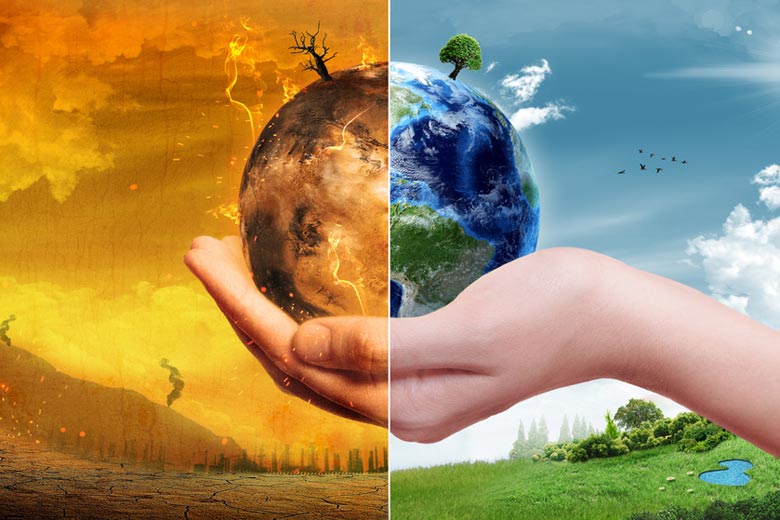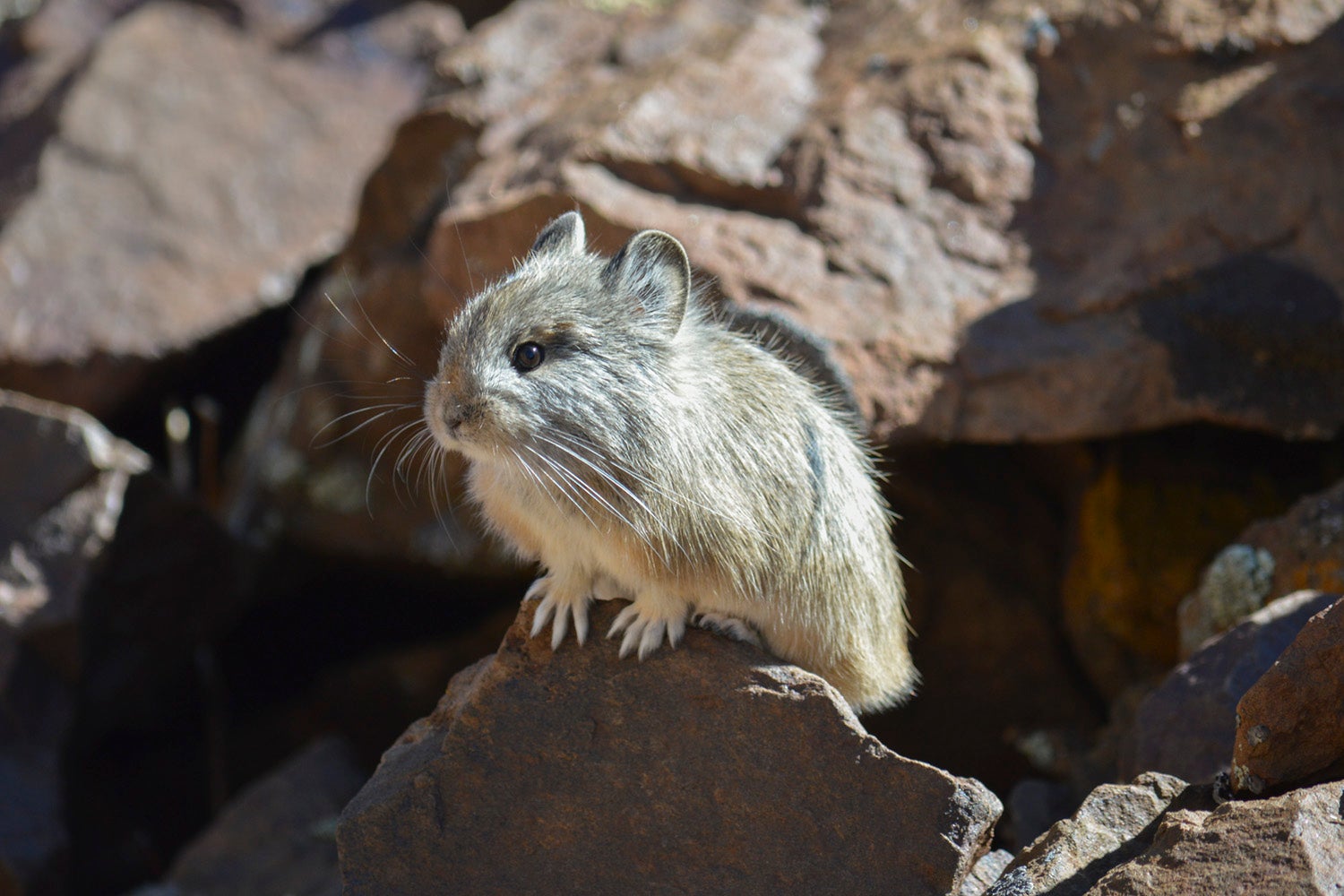The past year brought multiple extreme events to the US, including devastating wildfires to California and deadly hurricanes on the east coast. These are the types of extreme weather events that a 2018 study by Noah Diffenbaugh, the Kara J Foundation Professor of Earth System Science at Stanford’s School of Earth, Energy & Environmental Sciences (Stanford Earth) and his colleagues suggest could get more frequent if countries don’t work together to reach the goals laid out in the Paris Agreement.

Climate scientists and energy researchers at Stanford documented the devastating effects of climate change on the world and developed technologies to help reduce carbon emissions. (Image credit: ParabolStudio / Shutterstock)
Diffenbaugh and his colleagues analyzed the probability of extreme weather events if countries achieve the Paris Agreement goals – limiting global temperature rise to less than 2 degrees Celsius above pre-industrial levels – or if they simply achieve their individual commitments, which fall short of those goals.
“The really big increases in record-setting event probability are reduced if the world achieves the aspirational targets rather than the actual commitments,” Diffenbaugh said in a story about the work.
What’s more, under warmer global temperatures, extremely hot, dry weather is more likely to strike multiple regions at once, Diffenbaugh reported in a later study.
In addition to weather-related threats, rising seas pose an increasing risk as global temperatures heat up, according to a white paper this year by Alice Hill, a research fellow at the Hoover Institution, and Katharine Mach, a senior research scientist at Stanford Earth. They report that the rising seas are a risk both to coastal communities and to low-lying U.S. military installations around the world, posing a national security threat.
In a story about the work, Hill said, “The U.S. Department of Defense has repeatedly identified climate change as a ‘threat multiplier’ to national security. Three feet of sea-level rise would threaten 128 military installations, according to the Union of Concerned Scientists. For example, an important logistics hub on the Pacific island of Diego Garcia would be flooded if the sea level rises a few feet.” In addition to exploring threats, the group looked at ways to help communities adapt to the changing climate.
Later in the year, a report from the Global Carbon Project, an initiative led by Rob Jackson, the Michelle and Kevin Douglas Provostial Professor, found that the world is moving farther from the Paris Agreement goals with the second year of increases in emissions of carbon dioxide after a three year hiatus in growth.
“We thought, perhaps hoped, emissions had peaked a few years ago,” said Jackson, a professor of Earth system science, in a story about the work. In order to avert the worst effects of climate change, including the extreme weather events Diffenbaugh’s research predicts, “We need to stabilize emissions and then lower them to near zero as quickly as possible,” Jackson said.
In addition to weather effects, reversing the trend of increasing CO2 emissions could also save the world trillions, according to a study this year from Marshall Burke, assistant professor of Earth system science. In a story about the work, Burke said, “For most countries in the world, including the U.S., we find strong evidence that the benefits of achieving the ambitious Paris targets are likely to vastly outweigh the costs.”
New solutions
Despite grim news about increasing emissions and the threats posed by extreme weather and a sea-level rise, some news brought hope. Stanford announced a new solar installation that will bring the university to 100 percent renewable energy by 2021. Other technological advances this year include a device that could keep buildings cool while generating solar energy and a new type of battery that could store excess energy produced by wind or solar sources.

Stanford announced a new solar installation that will bring the university to 100 percent renewable energy by 2021. (Image credit: M. Scott Gould)
Another study by Adam Brandt, assistant professor of energy resources engineering, found that a major source of CO2 emissions at oilfields results from a practice called flaring – burning excess natural gas. In a story about the work, Brandt said, “Really, the challenge with flaring is there needs to be a policy or a regulatory apparatus to say, ‘Burning gas with no purpose isn’t allowed; put it back in the ground or find something useful to do with it.’”
In addition to suggesting ways of cleaning up oil extraction, Mach of Stanford Earth published a study this year finding that it may be economically feasible to capture some CO2 from the atmosphere and store it underground – known as carbon sequestration or negative emissions.
“There’s really no scenario that meets the world’s climate goals without negative emissions,” Mach said in a story about the work. Mach and her collaborators found that although most scenarios for carbon sequestration are cost-prohibitive, a type of sequestration could be profitable for ethanol producers.
Another study by Sally Benson, a professor of energy resources engineering, suggests that incentives for companies to pump CO2 into wells could be an economically feasible way to not only boost production but also remove the greenhouse gas from the atmosphere.
“If you look at air transport, shipping, heavy-duty land-based transportation, these are uses of fossil fuels that are definitely expected to grow,” Benson said in a story about the work. “As an insurance policy, getting everybody, including the oil and gas industry, to contribute to solving this problem is really important.”
These are just a few approaches to reaching the ultimate goal of becoming less reliant on fossil fuels. In a series of videos, eight faculty presented their ideas for what the future of energy could look like.
Impact on animals
Several studies this year focused on the effects of climate change on plants and animals, including this one about the dwindling supply of a fungus that serves as a major source of income in parts of the Himalayas.

Stanford researchers tracked pikas in the Indian Himalayas and took small samples of their blood in order to analyze how their genes were helping them adapt to different oxygen levels. (Image credit: Katie Solari)
Elsewhere in the Himalayas, mammals known as pikas are being driven to higher elevations as they flee the warming weather. A new study found reassuring news in the pikas’ genes – the animals are able to activate genes that allow them to use oxygen more efficiently as they move higher.
A story about the work describes the researchers’ pika-sized test equipment and modified high-altitude training chambers used to assess the animals’ adaptability. “We’re used to thinking about genetic adaptation taking thousands of years to occur in a species, but what’s exciting about this work is that this flexibility in gene expression could give at least the lower-elevation pika populations a better chance than we thought of being able to adapt to climate change on these short timescales,” said Elizabeth Hadly, the Paul S. and Billie Achilles Professor in Environmental Biology and senior author of the study.
In Canada, where the Peace-Athabasca Delta is slowly drying, another team of researchers studied a different mammal – the muskrat. With easy to find homes, muskrats are easy to count and serve as an indicator for species in the area. The team found that as freshwater areas dwindled, so too did muskrat homes.
“The ecological impacts are not limited to muskrat – they extend far beyond that,” doctoral student Ellen Ward said in a story about the work. “These results suggest that maybe the widespread continental-scale decline in this animal is actually being driven by a large-scale loss in wetland and aquatic habitat.”
But finally, it wasn’t all bad. As a doctoral student studying the fate of the yellow cedar tree in Southeast Alaska, Lauren Oakes, now a lecturer in the Emmett Interdisciplinary Program in Environment and Resources, found inspiration in how communities came together. In a story about her new book, Oakes said, “I feel that hope is this idea that somebody else might fix it. We’re looking for policy, or looking for everyone to get onboard with the Paris Agreement, or looking for President Trump to turn around, but I think more can come from individual action.”